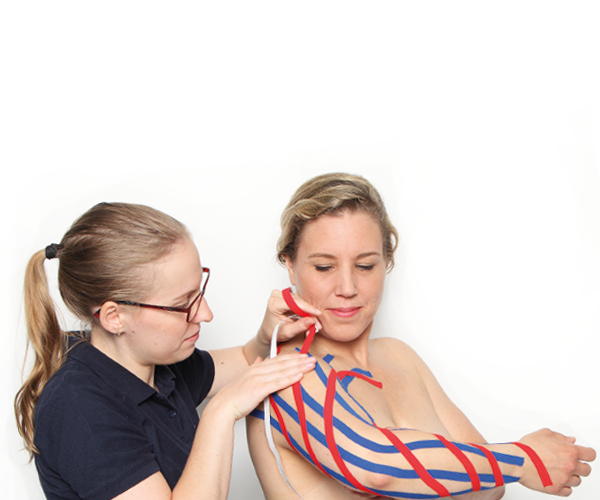

THE EASYTAPING-METHOD
The Swiss Easytaping method is successfully used worldwide in medical and paramedical treatments. It is based on the DAMT The Dynamic ArthroMyofascial Translation® Test abbreviated 4xT®Method ‘the ArthroMyofascial Therapy’.
The Easytaping method combines neuroreflective facilitation with myofascial control. This accelerates functional recovery by reducing mechanical steering of joints and pain. More than 13,000 physiotherapists, osteopaths, chiropractors, doctors, pelvic therapists, oedema therapists, exercise therapists, sports therapists, personal trainers and masseurs have already learned taping through Easytaping.

Innovation in Fasciatherapy: Easytape® and the 4xT Method
Research
The team behind Easytape® aims to get clients back to optimal functioning quickly. Although elastic tape is commonly used in practice, results vary from low to moderate, depending on various factors such as location and direction of application [1-3]. This led to the development of the 4xT method, which aims to improve these effects [5].
The 4xT method is a systematic approach within ArthroMyoFascial therapy, helping the therapist to choose appropriate interventions for musculoskeletal conditions. The 4 T's stand for: Test (functional diagnosis), Trigger (manual intervention), Tape (elastic tape) and Train (exercises) [5]. This method enables the therapist to effectively identify the cause of complaints and treat them using Easytape®.
Researchers at VU University Amsterdam are collaborating with Physio Physics to study this method further. By looking at the interaction between different anatomical structures, they aim to better understand how the ArthroMyoFascial complex works and how it contributes to treatment [6]. Case studies show that manipulations of the skin and fascia have significant impact on joint movement [7].
What is the relationship with Easytape®?
Easytape® can contribute to a longer-lasting effect in treatment. While manual interventions reduce the stiffness of certain structures, elastic tape actually appears to have a positive influence on the increase of this stiffness [11, 12]. This can be advantageous when the superficial fascia becomes stiffer, as Easytape® ensures efficient transfer of force to deeper tissues after manual interventions.
Practical effectiveness
The 4xT method has been further developed into a quick test procedure, the Dynamic Arthro-Myofascial Translation Test (DAMT-Test®), which helps to quickly identify the causes of complaints. This test has been validated for mobility change using motion capture technology [8]. The method clarifies when manual interventions or elastic tape are useful, which has led to improved treatment outcomes in practice [13].
Why is there an emphasis on fascia?
Traditional physiotherapy is based on ‘ancient anatomy’, in which muscles play the main role in movement. In the 4xT® Method, however, the focus is on fascia, the specialised connective tissue that connects everything in the body. When fascia adheres, joints and organs can twist, leading to blocked movements, weaker muscles, muscle tension and pain. The 4xT® Method tests through the fascia how movements can be improved and pain reduced, with immediately noticeable results.
Easytape® techniques
Easytape® is applied in a systematic way. There are several basic techniques you can learn through a course, such as the Skin-Fascia Translation and the Arthrofascial Translation. When applying the tape, accuracy is essential: the tape must be placed correctly with the right tension to achieve the desired effect, such as pain relief or joint support. Depending on the location and the intended therapeutic goal, the following techniques can be distinguished:
- Elastic stretching towards the centre: The tape is applied with tension directed towards the centre of the area to be treated, providing stability and support.
- Elastic stretching from the centre directed: Here, the tape is applied with tension directed from the centre of the treated area, which promotes decompression and mobility.
- Correction directed inwards or outwards: This technique is used to perform a correction, where the tape moves the structure inwards (medial correction) or outwards (lateral correction).
- Inward or outward translation: The tape is applied to support or restrict a translational movement, depending on the need for inward or outward stabilisation or mobilisation.
- Counterclockwise or clockwise rotation: Here, the tape is applied to promote or limit rotation in a counterclockwise (anti-clockwise) or clockwise (clockwise) direction, depending on the specific correction or support needed.
When applying these techniques, it is crucial to consider the individual anatomy and the specific purpose of the taping. Precise positioning of the tape and the right degree of tension are essential to achieve the desired therapeutic effects, such as pain relief, joint support, improvement of proprioception, and promotion of functional recovery.
In addition, the combination of different techniques in one taping protocol can increase effectiveness, depending on the complexity of the complaint and the correction or support needed.
The application of these taping techniques within the 4xT method thus offers a versatile and dynamic approach to supporting the recovery process and promoting functional performance in patients.
The combination of different taping techniques can further enhance effectiveness, depending on the patient's specific complaints. A thorough clinical evaluation is essential to determine the right approach.
Natural materials
Easytape® is made of cotton without synthetic additives, which contributes to a smaller ecological footprint. Although the tape is somewhat thicker due to the hypoallergenic adhesive, the use of tape is efficient, leading to better results with less material.
In a nutshell:
- Easytape® provides excellent support in fascia therapy, such as in the 4xT method.
- The product is affordable and accessible to professionals.
- Easytape® is available in various colours and sizes to suit different preferences and needs.
For more information on the techniques and methods, please visit specialised training courses on Taping and the 4xT method, designed to get you up to speed quickly and effectively.
References
1. Lau, K.K. and K.C. Cheng, Effectiveness of taping on functional performance in elite athletes: A systematic review. J Biomech, 2019. 90: p. 16-23.
2. Li, X., et al., Effects of Elastic Therapeutic Taping on Knee Osteoarthritis: A Systematic Review and Meta-analysis. Aging Dis, 2018. 9(2): p. 296-308.
3. Wang, Y., et al., Kinesio taping is superior to other taping methods in ankle functional performance improvement: a systematic review and meta-analysis. Clin Rehabil, 2018. 32(11): p. 1472-1481.
4. van Amstel, R.N., et al., A systematic review of lumbar elastic tape on trunk mobility: a debatable issue. Archives of Rehabilitation Research and Clinical Translation, 2021. 3(3): p. 100131.
5. Noten, K. The Dynamic ArthroMyofascial Translation® Test (DAMT®Test): 2012. (4xT®Method the ArthroMyofascial Therapy: Chapter 2). 2021. 10-15 DOI: https://doi.org/10.17605/OSF.IO/D85K3.
6. Noten, K. and R.v. Amstel, From Muscle–Bone Concept to the ArthroMyoFascial Complex: A Pragmatic Anatomical Concept for Physiotherapy and Manual Therapy. Life, 2024. 14(7): p. 799.
7. Van Amstel, R.N., et al., Conceptual Insights into the Relationship between Fasciae and Muscles and the Potential Working Mechanisms of Fascia Tissue Manipulations in Low Back Pain. SSRN, 2024: p. 62.
8. van Amstel, R.N., R.T. Jaspers, and A.L. Pool-Goudzwaard, Skin Displacement as fascia tissue manipulation at the lower back affects instantaneously the flexion-and extension spine, pelvis, and hip range of motion. Frontiers in Physiology, 2022. 13: p. 01-15.
9. Devantéry, K., et al., Effects of a Myofascial Technique on the Stiffness and Thickness of the Thoracolumbar Fascia and Lumbar Erector Spinae Muscles in Adults with Chronic Low Back Pain: A Randomized before-and-after Experimental Study. Bioengineering, 2023. 10(3): p. 332.
10. Hamilton, R.I., C.L. Garden, and S.J. Brown, Immediate effect of a spinal mobilisation intervention on muscle stiffness, tone and elasticity in subjects with lower back pain–A randomized cross-over trial. Journal of Bodywork and Movement Therapies, 2022. 29: p. 60-67.
11. Pamuk, U. and C.A. Yucesoy, MRI analyses show that kinesio taping affects much more than just the targeted superficial tissues and causes heterogeneous deformations within the whole limb. Journal of Biomechanics, 2015. 48(16): p. 4262-4270.
12. Wang, C.K., et al., Magnetic Resonance Elastography in the Assessment of Acute Effects of Kinesio Taping on Lumbar Paraspinal Muscles. Journal of Magnetic Resonance Imaging, 2019. 49(4): p. 1039-1045.
13. van Amstel, R.N. and K. Noten, Unlocking Pain Relief for Chronic Low Back Pain: The Potential of the 4xT Method®–A Dual Case Study Analysis. The American journal of case reports, 2023. 24: p. e939284-1.
14. van Amstel, R., et al., Fascia Tissue Manipulations in Chronic Low Back Pain: A Pragmatic Comparative Randomized Clinical Trial of the 4xT Method® and Exercise Therapy. Life, 2023. 14(1): p. 7.

Tamara Griekenspoor-Stam / Master Oncology Physiotherapist
„Better treatment results and patients are pain-free sooner."
Shoulder complaints and shoulder pain frequently due to post-breast cancer surgery. „Scars and radiogenic fibrosis can cause blockades, which keep the patient from properly controlling their shoulder joint. This again may lead to lymphedema in arms or breast and may cause pain“, Tamara explains.
Due to her specialization, Tamara frequently has to do with orthopedic complaints resulting from oncological treatment. „Myofascial release techniques help counteracting blockades caused by scars. Then we apply the 4xT-approach, which stands for testing, triggering, taping and training”, Tamara says.
„Easytape® Lymph & Scar Tape is applied after treatment. Easytape® Lymph & Scar Tape serves to stimulate the drainage of fluids for a long time. This supports increases treatment results and fasten pain-free mobility. The tape is pre-cut into long thin strips. This saves the practitioner a lot of time and effort and applying the tape is easy."
EASYTAPE® | ALL RIGHTS RESERVED | DISCLAIMER | PRIVACY POLICY

